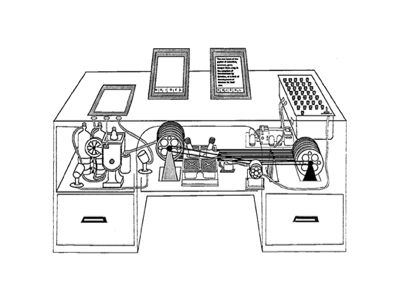
Imagining stuff is important!
This is Vannevar Bush’s machine, the Memex, published in his article As We May Think, just post-war. (image source)
It’s basically a microfiche reader. You have all your books in there, and you bring up whatever you want by pushing the keyboard.
The revolution in the Memex was the idea of the “trail.” You could select any piece of text you want, and join it to any other piece. Thus you could make trails of ideas that you could share with people. That was the big step: He thought about the links between books instead of the books themselves.
Importantly, two people read this article. One was Ted Nelson, who invented hypertext in 1963, which eventually inspired the Web a little less than 30 years later. The other was Doug Engelbart, who invented the mouse and modern computer interfaces—including the whole idea of using the computer as a personal tool rather than a calculating machine for shooting down missiles. He had his epiphany in the Philippines, I think it was, in a Red Cross hut, and read about the Memex in a magazine. He realised you could use a radar screen to give immediate feedback on what the computer was doing, and when he started his research programme, Silicon Valley was all orange groves, and there was only 4KB of computer memory in the world.